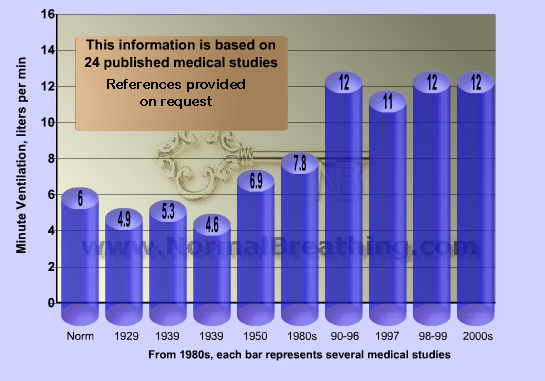Breathing rates are usually expressed as respiratory minute volume (or minute ventilation). It is calculated from the volume of air exhaled or inhaled in one minute. A rough calculation can be obtained by counting the number of inhalations per minute and multiplying that by the volume of air inhaled (assuming 500 ml per inhalation for an adult). Do not try to measure your own rate as the very act of breathing awareness will affect the outcome. When measuring a patient's breathing be sure they are unaware.
Accepted normal minute volume is about 5–8 litres per minute. Hyperventilation is the term for minute ventilation in excess of this.

Artour Rakhimov
Medical records from healthy male and female subjects from the 1920s–30s show average resting minute volumes of around 5 litres air per minute 1 2 .
However, modern records show much greater variability and higher values in the order of 12 litres of air per minute 3 4 5 6. This represents a staggering twofold increase in what is considered an acceptable breathing volume in less than fifty years. A sharp rise in the 80s and 90s coincides with increasing BMIs and dramatic rise in conditions such as asthma, allergies, sleep apnoea, heart disease, diabetes, cancer.
It is significant perhaps that breathing rates were routinely measured in hospitals up until 30 years ago. If the practice continued today there would most certainly be some surprises.
The Buteyko Breathing Clinics routinely record large-volume upper chest breathing pattern and rates in excess of 20 breaths/minute. Breathing rates of 12 litres/minute were measured in all subjects on the first Western Buteyko trial at Brisbane Hospital. The Buteyko group reduced ventilation to an average of 9 litres minute against the control group that showed no change.
There is limited research on respiratory rates and volumes and the field is complicated by the difficulty of accurately measuring and interpreting results. However one thing is clear: breathing rates are on the rise and appear to coincide with a corresponding rise in the diseases of civilization. Elsewhere on this website you can read about the physiology underpinning these conditions and it is not hard understand how breathing is perhaps one of the more important considerations if we are to enjoy optimal health and wellbeing.
1 Griffith FR, Pucher GW, Brownell KA, Klein JD, Carmer ME, Studies in human physiology. IV. Vital
capacity, respiratory rate and volume, and composition of the expired air. Am. J. Physiol 1929, vol. 89, p. 555.
2 Shock NW, Soley MH, Average Values for Basal Respiratory Functions in Adolescents and Adults, J.
Nutrition, 1939, 18, p. 143.
3 G J Tortora & N P Anagnostakos, Principles of Anatomy and Physiology, 6th edition, New York: Harper-Collins, 1990
4 Brian S. Beckett, Illustrated Human and Social Biology, Oxford: Oxford University Press, 1995
5 Lauralee Sherwood, Fundamentals of Physiology: A Human Perspective, Thomson Brooks/Cole, 2006
6 A. Chandrasekhar, MD Respiratory Rate and Pattern of Breathing Loyola University Medical Network



